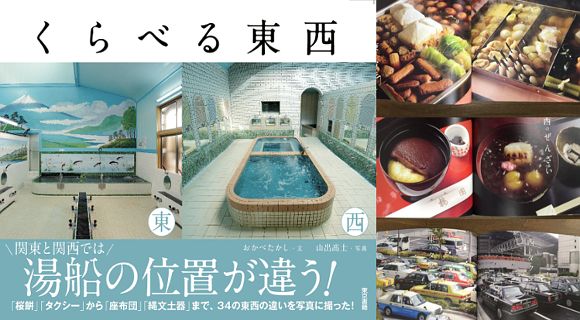"Kuraberu Tozai" presents an easy-to-understand compilation of regional differences between Tokyo and Osaka in terms of cuisines, art, and cultural traditions.
With visitors to Japan often making the journey between Tokyo, located in the eastern Kanto region, and Osaka and Kyoto, located in the western Kansai region of the country, many people will have noticed the cultural differences that exist between two of the nation’s most populous areas. When riding on the escalator in the Kanto region, (Tokyo, Chiba, Saitama, Gunma, Tochigi, Ibaraki, and Kanagawa), it’s customary to stand on the left, while in Kansai (Osaka, Kyoto, Nara, Mie, Wakayama, Hyogo, and Shiga), people are said to stand on the right. There are interesting differences in the language too, with the Kansai-ben regional dialect replacing “arigato” with “ookini” for “thank you“.
People in Japan and around the world are continually fascinated by the intriguing distinctions between the two areas, and now there’s a new book on the scene dedicated to addressing the subject through a series of easy-to-understand images.
Called “Kuraberu Tozai”, or “East and West Compared”, the cover of the book instantly draws readers into the subject with the image of a public bath placed by the wall in the eastern region of Japan (left) and in the center of the room in the west (right).
Inside, there are a number of beautiful side-by-side images showing the distinctions between east (東) and west (西) Japan.
There are colorful taxi cabs on the roads of Kanto, compared to sleek, dark taxi cabs in Kansai.
The difference between the slicing of negi leeks used in cooking is even addressed. The warm sweet red bean paste dessert known as "zensai" are also served differently according to the region. There are differences between the country’s "shichimi" seven-spice mixture. Even the little parcels of inarizushi soy-wrapped rice morsels are packed differently in the Kanto and Kansai areas.
The book also asks readers to spot the difference between "zabuton" cushion seats in each region.
All these interesting comparisons and distinctions have been inspiring Twitter users to think of their own ideas, like this one that compares the differences between the cold noodle dish known as "Hiyashi Chuka."
The book is currently available on Amazon Japan and at bookstores around the country, and with the popularity of the book soaring online through social media, it won’t be long before it makes its way to cafes and hotel lobbies from east to west for tourists and visitors to flick through.
Source: Togetter
Read more stories from RocketNews24. -- Kansai and Kanto prove again that they are each distinct regions when it comes to food -- Kansai scraps “power off” mobile phone ban on trains; Kantō won’t budge -- Around Japan in 47 rice balls: Mr. Sato buys each prefecture’s musubi all from one Tokyo shop
© Japan Today Take our user survey and make your voice heard.
Take our user survey and make your voice heard.















1 Comment
Login to comment
Nippori Nick
I have read so many times about the stand on the left, stand on the right difference.
Really, is that supposed to be of earth shaking importance? It's amazing how Japan tries to find the most minor differences in regions and then thinks they are so important..